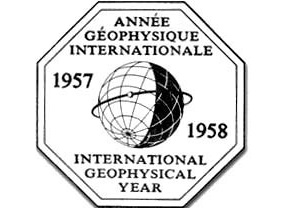By Vicki Zwart
Two of the American Geophysical Union’s most prominent past members were among the masterminds behind the International Geophysical Year (IGY), “an unprecedented study of our physical environment.” According to former Union president James Van Allen in Eos, Vol. 64, no. 50, at a dinner party he hosted in April of 1950, Lloyd Berkner, a leading expert on ionospheric physics (and a former AGU president as well), asked renowned British geophysicist Sydney Chapman, “Don’t you think it’s about time for another International Polar Year?” Chapman readily agreed and their conversation quickly turned to how they could pull off such a monumental project. They picked the year 1957-1958 because it would be the 25th anniversary of the Second Polar Year and it was expected to have maximum solar activity.
The two men garnered the support of the geoscientific community, broadened the scope, and the period from August 1957 to December 1958 was designated the International Geophysical Year by the International Council of Scientific Unions. AGU Fellow Joseph Kaplan was appointed chairman of the U.S. National Committee for the IGY in 1953 and spent a decade managing the ambitious endeavor along with the wealth of knowledge gained by the collaborative effort between nations. Nearly 80,000 scientists and volunteers from 67 countries gathered data at about 8,000 stations from pole to pole. Chapman said in Transactions, Vol. 20, no. 2, that “it gave proof that however many and serious the political problems that trouble the human race, it is possible for the nations to work together in a great enterprise planned for the common good.”
While many AGU scientists contributed important research to IGY, the society did its part as well, including hosting a two-day symposium on the Antarctic in April 1956, with Kaplan previewing the program and others delving into the region’s main geophysical interests. It led to the publication of the Union’s first monograph - “Antarctica in the Geophysical Year.”
Factoids
The first two International Polar Years were held in 1882-1883 and 1932-1933, focusing on the geophysics of the polar regions, mainly the Antarctic, with intense study and expeditions.
The International Committee on the International Geophysical Year was led by chairman Sydney Chapman and vice chairman Lloyd Berkner.
AGU also published in Transactions the National Academy of Sciences’ monthly IGY Bulletin. Included were brief articles and reports on projects and experiments in the U.S. program along with news of activities of other countries. Its publication continued until April 1965.
The Antarctic Treaty of 1959 was a direct result of the IGY; it prohibited the testing of nuclear weapons on the continent.
The Committee for the International Geophysical Year 1957-1958 adopted the view to extend the scope of observations to the entire world, so that’s why the title was changed to an “International Geophysical Year” instead of a “Polar Year.”
The IGY led to the space race with the USSR’s launch of the first artificial Earth satellite, Sputnik I in October 1957. The first US-IGY satellite was launched three months later from Cape Canaveral, Florida.



